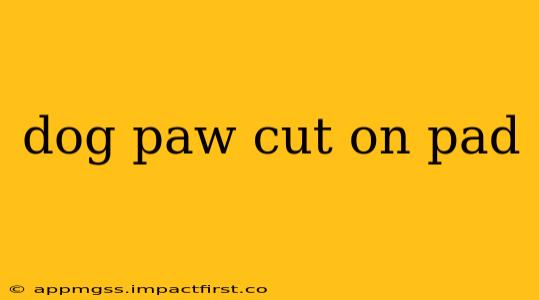A cut on your dog's paw pad can be a painful and distressing experience for both you and your furry friend. Paw pads are crucial for your dog's mobility, balance, and overall well-being, so even minor injuries require careful attention. This guide will cover everything you need to know about treating a cut on your dog's paw pad, preventing future injuries, and recognizing when to seek professional veterinary care.
How to Treat a Minor Cut on Your Dog's Paw Pad
For small, superficial cuts that don't involve deep wounds or excessive bleeding, you can often provide initial first aid at home. The key is to keep the wound clean and protected to prevent infection.
-
Clean the Wound: Gently wash the paw pad with mild soap and lukewarm water. Avoid harsh chemicals or scrubbing, as this can irritate the sensitive skin. Pat the area dry with a clean towel.
-
Apply Antibiotic Ointment: A thin layer of antibiotic ointment, like Neosporin (ensure it's specifically formulated for animals and doesn't contain lidocaine, which can be toxic to dogs), can help prevent infection.
-
Bandage (Optional): For small cuts, a bandage may not be necessary. However, if the wound is in a location that's prone to irritation or your dog is constantly licking it, you might consider a bandage. Use a non-stick, breathable bandage to allow the wound to heal properly and avoid further irritation. Check the bandage regularly to ensure it's clean and dry.
-
Monitor for Signs of Infection: Keep a close eye on the wound for signs of infection, such as increased swelling, redness, pus, or a foul odor. If you notice any of these, consult your veterinarian immediately.
What if the Cut is Severe or Bleeding Heavily?
Severe cuts, deep wounds, or excessive bleeding require immediate veterinary attention. Do not attempt to treat these injuries at home. Contact your veterinarian or an emergency animal hospital immediately. Deep cuts may require stitches or other surgical intervention.
How Can I Prevent My Dog from Cutting Their Paw Pads?
Preventing paw pad injuries is crucial to your dog's comfort and well-being. Here are some preventative measures you can take:
-
Regular Paw Pad Inspections: Regularly check your dog's paw pads for any cuts, abrasions, or foreign objects.
-
Protective Footwear: Consider using dog boots, especially in harsh weather conditions (snow, ice, extreme heat) or when walking on rough terrain.
-
Careful Walks: Avoid walking your dog on hot asphalt or sharp objects. Be mindful of the terrain you're walking on and consider using alternative routes if necessary.
-
Trim Your Dog's Nails: Long nails can cause discomfort and increase the risk of injury. Keep your dog's nails trimmed to a safe length.
-
Address Underlying Medical Conditions: Conditions such as allergies or autoimmune diseases can make paw pads more susceptible to injury. Address these issues with your veterinarian.
How Long Does it Take for a Dog Paw Pad Cut to Heal?
The healing time for a paw pad cut varies depending on its severity. Minor cuts may heal within a few days to a week, while more severe injuries may take several weeks or longer. Always follow your veterinarian's instructions for aftercare and monitor the wound closely.
What are the Signs of Infection in a Dog's Paw?
Recognizing signs of infection is vital to your dog's health. Look for:
- Increased Swelling: Significant swelling beyond the initial trauma.
- Redness: Increased redness around the wound.
- Pus: Thick, yellowish or greenish discharge from the wound.
- Foul Odor: An unpleasant smell emanating from the injured paw.
- Lameness: Your dog is reluctant to put weight on the affected paw.
- Fever: An elevated body temperature.
If you notice any of these signs, contact your veterinarian immediately. Early intervention can significantly improve the outcome.
When Should I Take My Dog to the Vet for a Paw Pad Injury?
It's always best to err on the side of caution when it comes to your dog's health. Seek veterinary care if:
- The cut is deep or bleeding heavily.
- The wound shows signs of infection.
- Your dog is exhibiting significant pain or lameness.
- You are unsure how to properly care for the injury.
By following these guidelines and promptly addressing any concerns, you can help ensure your dog's paw pads remain healthy and happy. Remember, preventative care and regular paw pad inspections are crucial for avoiding injuries in the first place.
